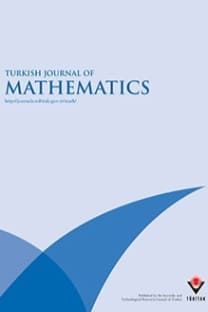Relative ranks of some partial transformation semigroups
Relative ranks of some partial transformation semigroups
___
- [1] Al-Kharousi F, Kehinde R, Umar A. Combinatorial results for certain semigroups of partial isometries of a finite chain. Australasian Journal of Combinatorics 2014; 58(3): 365-375.
- [2] Ayık G, Ayık H, Howie JM. On factorisations and generators in transformation semigroup. Semigroup Forum 2005; 70: 225-237.
- [3] Ayık G, Ayık H, Howie JM, Ünlü Y. Rank properties of the semigroup of singular transformations on a finite set. Communications in Algebra 2008; 36: 2581-2587.
- [4] Ayık H, Bugay L. Generating sets of finite transformation semigroups PK(n, r) and K(n, r) . Communications in Algebra 2015; 43: 412-422.
- [5] Bugay L, Yağcı M, Ayık H. The ranks of certain semigroups of partial isometries. Semigroup Forum 2018; 97: 214-222.
- [6] East J. Infinite partition monoids. International Journal of Algebra and Computation 2014; 24: 429-460.
- [7] Evseen AE, Podran NE. Semigroups of transformations generated by idempotents of given defect. Izvestiya Vysshikh Uchebnykh Zavedenii. Matematika 1972; 117: 44-50.
- [8] Ganyushkin O, Mazorchuk V. Classical Finite Transformation Semigroups. Berlin, Germany: Springer-Verlag, 2009.
- [9] Garba GU. Idempotents in partial transformation semigroups. Proceedings of the Royal Society of Edinburgh 1990; 116A: 359-366.
- [10] Garba GU. On the nilpotent ranks of certain semigroups of transformations. Glasgow Mathematical Journal 1994; 36: 1-9.
- [11] Gomes GMS, Howie JM. Nilpotents in finite symmetric inverse semigroups. Proceedings of the Royal Society of Edinburgh 1987; 30: 383-395.
- [12] Hardy GH, Wright EM. An Introduction to the Theory of Numbers. New York, USA: Oxford University Press, 1979.
- [13] Higgins PM. The product of the idempotents and an H-class of the finite full transformation semigroup. Semigroup Forum 2012; 84: 216-228.
- [14] Howie JM. Fundamentals of Semigroup Theory. New York, NY, USA: Oxford University Press, 1995.
- [15] Howie JM, McFadden RB. Idempotent rank in finite full transformation semigroups. Proceedings of the Royal Society of Edinburgh 1990; 114A: 161-167.
- [16] Kearnes KA, Szendrei Á, Wood J. Generating singular transformations. Semigroup Forum 2001; 63: 441-448.
- [17] Levi I, McFadden RB. Sn -Normal semigroups. Proceedings of the Royal Society of Edinburgh 1994; 37: 471-476.
- [18] Lipscomb S. Symmetric Inverse Semigroups, Mathematical Surveys and Monographs. Providence, RI, USA: American Mathematical Society, 1996.
- [19] Yiğit E, Ayık G, Ayık H. Minimal relative generating sets of some partial transformation semigroups. Communications in Algebra 2017; 45: 1239-1245.
- ISSN: 1300-0098
- Yayın Aralığı: 6
- Yayıncı: TÜBİTAK
Longest increasing subsequences in involutions avoiding patterns of length three
Toufik MANSOUR, Gökhan YILDIRIM
Ricci–Yamabe maps for Riemannian flows and their volume variation and volume entropy
Mircea CRASMAREANU, Sinem GÜLER
Laiachi El KAOUTIT, Leonardo SPINOSA
Muhammad NAEEM, Saqib HUSSAIN, Fethiye Müge SAKAR, Tahir MAHMOOD, Akhter RASHEED
On ps-Drazin inverses in a ring
Huanyin CHEN, Tuğçe PEKACAR ÇALCI
Lattice ordered semigroups and hypersemigroups
Parviz Sadat HOSSEINI, Bahmann YOUSEFI
Automorphisms of free metabelian Leibniz algebras of rank three
